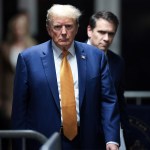Dana Perino, the White House spokeswoman caught in the Dick Cheney information-security scandal, relies on the fact that she’s not a lawyer to deflect questions on Cheney’s claims to be outside both the executive and the legislative branches of government. What’s David Addington’s excuse?
Addington — who served as Cheney’s chief lawyer before becoming his chief of staff after Scooter Libby was indicted — wrote a letter (pdf) to Sen. John Kerry (D-MA) yesterday defending Cheney’s asserted exemption from review by the National Archives’ Information Security Oversight Office. He’s got two options: either argue that the Office of the Vice President is outside the scope of the executive order governing review of how executive branch agencies are supposed to handle classified material, or return to the claim that the veep is a unique branch of government and is exempt by default. Addington, somewhat surprisingly, chooses Option One.
The executive order on classified national security information — Executive Order 12958 as amended in 2003 — makes it clear that the Vice President is treated like the President and distinguishes the two of them from “agencies.” The executive order gives the ISOO, under the supervision of the Archivist of the United States, responsibility to oversee certain activities of “agencies,” but not of the Vice President or the President.
As TPMmuckraker highlighted yesterday, that amended order, known as Executive Order 13292, doesn’t just deal with “agencies,” it also deals with Executive Branch “entities.” Former Justice Department lawyer Marty Lederman explains that because both the President’s office and the OVP “are ‘entities’ within the Executive branch, they are ‘agencies’ covered by the E.O. (see section 6.1(b)) under a plain reading of the E.O.”
This “plain reading” is the most likely explanation for why Addington concocted the theory that Cheney’s office is a fourth branch of government — after all, the only way not to be an “entity” within the executive branch, thereby avoiding ISOO scrutiny, is to be, well, outside the executive branch. That theory (pdf) is what prompted Kerry’s letter in the first place, and a lawyer as confident of his reasoning as Addington is might be expected to stand his ground. Alas, no:
Constitutional issues in government are best left for discussion when unavoidable disputes arise in a specific context instead of in theoretical discussions. Given that the executive order treats the Vice President like the President instead of like an “agency,” it is not necessary in these circumstances to address the subject of any alternative reasoning, based on the law and history of the legislative functions of the vice presidency, and the more modern executive functions of the vice presidency, to reach the same conclusion that the vice presidency is not an “agency” with respect to which ISOO has a role.
When a bit of constitutional “alternative reasoning” is too much for even David Addington to defend, chances are others won’t exactly “reach the same conclusion.”





 Today’s Must Read
Today’s Must Read


